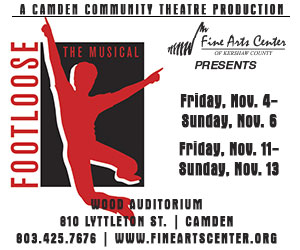Choral Arts in Columbia and Beyond
By Evelyn Morales
Choral singing has come a long way from the days of Ancient Greek repertory and the Gregorian chant. Columbia itself has a rich history of vocal arts, which is exemplified in the works of the Arpad Darazs Singers, the Sandlapper Singers, and the Palmetto Mastersingers, among several other choral groups in the area. While these three choruses share a love and appreciation for singing as a group, they have different influences that make them both unique and inviting to audiences. For example, the Palmetto Mastersingers, formed in 1981 by the late Dr. Arpad Darazs, is an all-male chorus with international renown. The Sandlapper Singers, a group formed in 1996 by its director, Dr. Lillian Quackenbush, focuses on using the works of American composers. And the Arpad Darazs Singers, formed in 1987 by former USC students, emphasizes a more accessible, community-based chorus. Together, these choruses represent great diversity and range.
Walter Cuttino, Music Director of the Palmetto Mastersingers since 1998, uses a familiar term, “E Pluribus Unum – out of many, one,” to describe the dynamics of a choir: “I have lots of friends who are artists, painters, and poets, and that’s great. The thing I like about choral singing is that it’s a unit. It’s an ensemble. It’s teamwork. You have to be a part of the team, and you have to do your role within the team, which makes it more challenging, but I find it makes it more powerful.”
The Palmetto Mastersingers have toured in France, Germany, Russia, China, Canada, and Italy and look forward to an Alaskan/Canadian tour this summer. Known as “South Carolina’s Musical Ambassadors,” the group has performed at the White House and the Notre Dame Cathedral. Collaborations with local jazz musician Dick Goodwin and his band have resulted in albums focusing on beach as well as Rat Pack music.
Quackenbush, Director of the Sandlapper Singers, is excited about the group’s first international excursion to Ireland at the request of Music Celebrations International. “It’s a 10-day tour of Southwest Ireland, beginning July 15th through July 24th, 2012,” she says. “We will be performing with Irish groups as well, an opportunity to get to know the locals, so to speak.” The Sandlapper Singers’ focus on American music is a testimony to the abundance of national music available to them.
Perhaps more inclusive are the Arpad Darazs Singers. Bill Todd is both a member of the group and serves on its Board of Directors. He recognizes that choral singing may seem intimidating to some. “I don’t read music, but when I do, I read it very slowly,” Todd explains. His laid-back presence puts novices at ease.
“I really think that there is a belief that you really have to be, if not professional-grade, at least really good, and it’s really not true,” Todd says. “If you enjoy singing in the shower and can carry a tune and hear the notes, you can sing with the choir, and it’s a lot of fun. We do it because we have a good time. We don’t get paid anything. It’s a substantial commitment of time. Nobody would do this if they didn’t enjoy it.”
Choral singing does not immediately come to mind when people think about “the arts.” However, a chorus is as much a musical instrument as a violin or a piano. The integration of musical and vocal instruments can move people to great emotion, just as a dancer or a painting can. Indeed, recent performances by the Sandlapper Singers have featured the paintings of local artist Eileen Blyth as well as the grace and athleticism of Vibrations Dance Company. “They did some choreography with several dancers that went on during the music. It’s not just one element, just singers and piano; there’s a lot more going on,” Quackenbush explains. The Sandlapper Singers notably presented the late James Dickey’s poem, “Falling,” in its choral performance.
“We had to jump through a lot of hoops to get permission from his literary estate to use the text,” Quackenbush recalls. “We commissioned a woman out of Minnesota, Libby Larson, an internationally recognized composer, and she took James Dickey’s poem and put it to music. We performed that at the Koger Center on September the 8th, 2001, three days before September 11th.”
Stereotypes of choral singing elicit predictable images of older citizens and staid church congregations, and Quackenbush admits this may be true − to an extent. “Typically the people that are interested in choral music have been white-haired, and that’s not untrue of us,” she says. However, the addition of the Young Sandlapper Singers to the Sandlapper Singers family is challenging the public’s perception of what a choir can be. The Young Sandlapper Singers gave their first concert on December 2, 2011, and Quackenbush hopes they will “draw their families in, so we’ll have a broader range of ages, as well as a bigger spectrum of ethnicity so we can broaden our demographic.”
Cuttino is also familiar with the stereotypes but insists that a chorus is capable of performances beyond the religious variety. “If you’re going to church, you’re looking for a religious experience, and the choir enhances that experience. If you’re going to a Mastersingers concert, you are going for a musical experience, and hopefully it becomes an emotional musical experience,” Cuttino says. “We try to vary our repertoire so we can appeal to a lot of people. I’m very proud of that.”
Adult choruses can range in age from 15 to 80, with older members making up the majority. In order to appeal to a larger audience and to continue the choral tradition, recruiting a younger demographic and reaching out to more accessible public venues is important. Todd laments that the Arpad Darazs Singers do not have a formal outreach program to recruit younger choral candidates. “We would like to make a stronger effort in that direction,” he says.
The Arpad Darazs Singers embrace a lighter side of their Hungarian-born namesake. “I think he wanted everyone who had the ability to be able to carry a tune to have an opportunity to sing choral music, and that’s why he found so many different groups,” Todd explains. “I think we are more of a community group where people just like to get together and sing.”
Each choral group has its own audition schedules and requirements. Those interested in auditioning for the Sandlapper Singers can expect to audition directly with Quackenbush. “I audition on demand,” she says. “When people are interested, I’m interested in hearing them. I don’t always have a position open for them, but I want to know what they could bring to the ensemble.” The all-male Palmetto Mastersingers hold auditions for the first three rehearsals of their concert season. While knowing how to read music is preferred, Cuttino is willing to work on a diamond-in-the-rough. In addition to being able to sing, the group seeks people who can match pitch and sing in tune. The community-minded Arpad Darazs Singers cast a wider net and are highly approachable to the novice vocalist. “If they have a nice voice, we’ll take them,” Todd says with a smile.
The Columbia-based choruses typically perform three to five main concerts a year, along with intermittent special events. They frequently perform at Christmas concerts at venues such as high schools, churches, colleges, and community centers. Some upcoming performances include:
- “Songs of the Spirit” by the Sandlapper Singers, Friday, March 30, 2012, at 7:30 p.m. at Dreher High School Performing Arts Center. Tickets are $15 for adults and $5 for students. Details online at sandlappersingers.org.
- A concert by the Palmetto Mastersingers, Sunday, January 15, 2012, at 6 p.m. at the Sun City Hilton Head Community Association in Bluffton. Tickets are $20 for adults and $10 for students. Details online at palmettomastersingers.org.
- The Arpad Darazs Singers’ 2012 concert schedule has yet to be announced, so check the group’s website at adsingers.org for updates. Admission to all Arpad Darazs Singers concerts is free, and donations are accepted.






.jpg)
